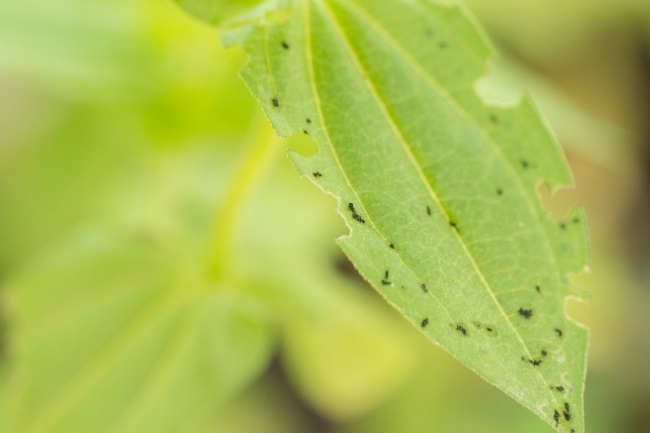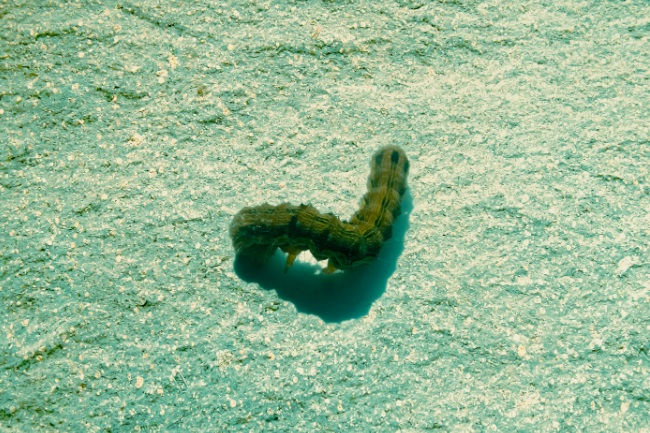Caterpillar poop is often called frass and usually comes in the form of pellets. These pellets are typically dropped on the ground near the caterpillar. However, some species fire them out as far as they can to avoid attracting predators.
Contents
What is frass?

Frass is the word used to describe the poop of many insect species. In these species, the insects waste is usually expelled in one mass, rather than having separate urine and faeces that like humans and other mammals. They do this to avoid excess water loss, as many insects are susceptible to desiccation (drying out). Some insects produce a separate honeydew, a sweet liquid designed to expel excess sugars taken in from sap.
Frass can look very different in different species, depending on what they eat. However, as most caterpillars are herbivores, eating primarily leaves of different plant species, mostly their frass is very similar. Expelled as a hard pellet with a knobby texture, caterpillar frass is pretty tricky to spot in the natural environment.
Sometimes it accumulates immediately below the caterpillar on the leaf surface when you are most likely to notice it. Some caterpillars that eat wood produce a much softer sawdust-like frass.
| Caterpillar Species | Frass Appearance |
|---|---|
| Monarch (Danaus plexippus) | Small, cylindrical pellets |
| Tomato Hornworm (Manduca quinquemaculata) | Large, greenish-black pellets |
| Eastern Tent Caterpillar (Malacosoma americanum) | Dense, black, and elongated masses |
| Cabbage White (Pieris rapae) | Small, greenish or yellowish pellets |
| Gypsy Moth (Lymantria dispar) | Sparse, light-colored pellets |
Also read: Does a Caterpillar Need Water? (Desiccation Explained)
Explosive poop

Have you ever seen a caterpillar poop? Probably not. However, if you do get the chance, you might get to see a genuinely explosive event. Caterpillars poop a lot, mainly because they eat almost constantly. This frass contains a hodgepodge of chemicals, fungi and nutrients, all the leftovers from the food they have been ingesting. However, many predatory species, such as wasps, can follow the scent of the frass and use it to guide them to where the caterpillars are. To help hide themselves away, some species of caterpillar fire their poop out as far as it can go.
Not all caterpillars are such great housekeepers, though. Tent forming caterpillars that live as a community within large silken nets just tend to expand their nets to get away from the poop accumulating within their homes.
| Frass Characteristics | Description |
|---|---|
| Size and Shape | Varies based on caterpillar species and diet |
| Color | Can range from green to brown or black |
| Texture | Typically dry and pellet-like, but can vary in consistency |
| Odor | Generally odorless, but some species may have a slight smell |
| Accumulation Patterns | Frass can be found in scattered piles or trails along the caterpillar’s feeding path |
Other caterpillars that poop in their homes include the leaf miner moth caterpillars. These tiny caterpillars spend their time crawling through tunnels of their own, making that wind their way through the insides of leaves. The caterpillars rarely leave their tunnels, if at all, so frass is simply left behind them within the walls of the leaves.
Also read: What do Caterpillars Eat? (Vegan vs. Carnivore Caterpillars)
The great natural fertiliser
We are well aware of the impact mammal and bird poop has on the ecosystem, from birds spreading seeds to mammals fertilising grasslands. Without this cycling of nutrients, many ecosystems would be much less fertile. However, insect frass often isn’t considered; after all, the poop of ants, termites and spiders is tiny, isn’t it, so what kind of effect would it possibly have? Yet insect waste is an essential part of the ecosystem and a very large one too.
Afterall there are estimated to be around five millions insect species; imagine how many individual insects there are?
Caterpillars chomp up vegetation, or sometimes other insects, and then let those droppings fall to the ground. They make an excellent fertiliser, feeding the plants with highly accessible nutrients. Much of the time, the frass falls to the ground near the plant they are feeding on, helping boost its growth, suitable for the plant and the caterpillar. Of course, the plant would probably do much better if it wasn’t being munched on in the first place.
Humans have even learnt to use this fertiliser in the same way. Collecting the caterpillar frass and spreading it on their gardens. While it may not be worth your while to go out collecting caterpillar poop on your hands and knees, this can be a valuable bi-product of caterpillar and butterfly rearing. People rear caterpillars for all kinds of reasons, for the production of silk, to eat, or even for pleasure.
Also read: Earthworm Poop – Its Benefits, How Does it Look Like & More
Caterpillar frass tricks plants

Some fascinating research has shown how armyworm caterpillars use their frass to trick their host plants into mounting the wrong defence. The corn plants they feed on are only capable of defending themselves against one attack at a time.
While the caterpillars are happily feeding on the leaves of the corn, the frass that drops to the ground around the plant sends out chemicals that trick it into thinking it’s a fungal attack it’s under. The plant then builds up chemicals to help it deal with the imagined fungal attack, while the toxins it would typically use to put off herbivores remain dormant.
Also read: What Caterpillar Eats Parsley? (List of Species)
Caterpillars: Poop machines
We tend to focus more on what animals eat than what comes out on the other end, but poop is very important for the growth of plants. By fertilising the soil, the plants grow more robust and more vigorously, which is great for caterpillars who need tasty food to help them to get big strong. It may be hard to spot, but if you look around where caterpillars are busy feeding, you might get lucky and spot some of the hard pellets they leave behind them.

